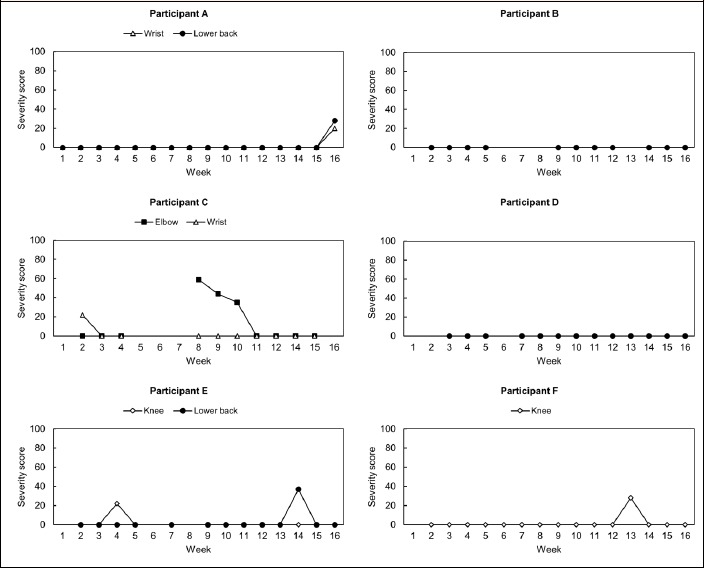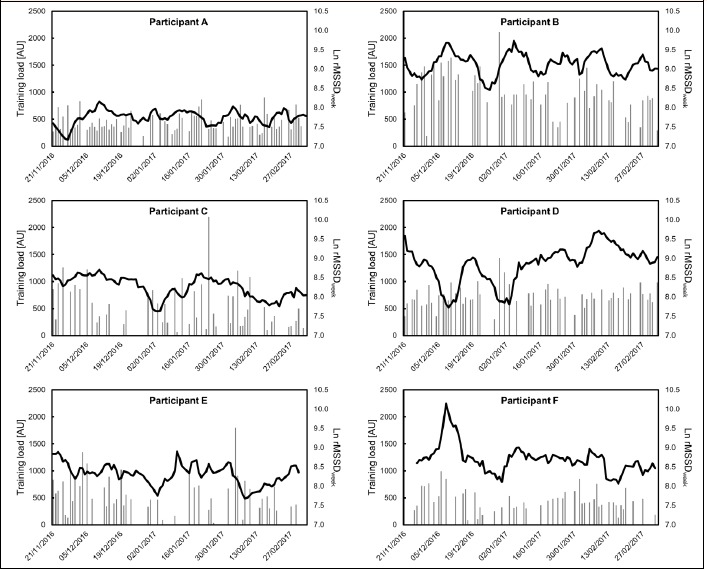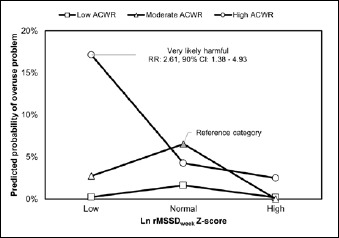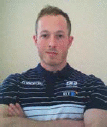Abstract
Heart rate variability (HRV) is a popular tool for monitoring training adaptation and readiness in athletes, but it also has the potential to indicate early signs of somatic tissue overload prior to the onset of pain or fully developed injury. Therefore, the aim of this study was to investigate the interaction between HRV, workloads, and risk of overuse problems in competitive CrossFit™ athletes. Daily resting HRV and workloads (duration × session-RPE) were recorded in six competitive CrossFit™ athletes across a 16 week period. The Oslo Sports Trauma Research Center Overuse Injury Questionnaire was distributed weekly by e-mail. Acute-to-chronic workload ratios (ACWR) and the rolling 7-day average of the natural logarithm of the square root of the mean sum of the squared differences between R–R intervals (Ln rMSSDweek) were parsed into tertiles (low, moderate/normal, and high) based on within-individual z-scores. The interaction between Ln rMSSDweek and ACWR on overuse injury risk in the subsequent week was assessed using a generalized linear mixed-effects model and magnitude-based inferences. The risk of overuse problems was substantially increased when a ‘low’ Ln rMSSDweek was seen in combination with a ‘high’ ACWR (relative risk [RR]: 2.61, 90% CI: 1.38 – 4.93). In contrast, high ACWRs were well-tolerated when Ln rMSSDweek remained ‘normal’ or was ‘high’. Monitoring HRV trends alongside workloads may provide useful information on an athlete’s emerging global pattern to loading. HRV monitoring may therefore be used by practitioners to adjust and individualise training load prescriptions, in order to minimise overuse injury risk.
Key points.
Reductions in HRV concurrent with workload spikes were associated with an increased risk of developing overuse problems.
High workloads were well-tolerated when HRV trends remained ‘normal’ or ‘high’.
HRV monitoring may therefore be used by practitioners to adjust and individualise training load prescriptions, in order to minimise overuse injury risk.
Key words: Cardiac parasympathetic function, monitoring, training load
Introduction
Overuse injuries occur due to repetitive submaximal loading of the musculoskeletal system when rest is not adequate to allow for structural adaptation to take place (DiFiori et al., 2014). The prevalence and negative impact of overuse injuries in competitive sports (Clarsen et al., 2013) highlights the need for monitoring systems that can accurately reflect athletes’ evolving adaptations to training stimuli (Gisselman et al., 2016). Heart rate variability (HRV) is a popular tool for monitoring wellness and training adaptation in athletes (Bellenger et al., 2016). HRV involves measurement of the variation between individual heart beats across consecutive cardiac cycles, and this variation can provide an estimate of a person’s autonomic nervous system (ANS) activity (Malik, 1996). The emergence of smartphone applications and technologies has dramatically increased the accessibility of HRV measurement, such that it can now be recorded accurately using only a smartphone device (Plews et al., 2017).
The ANS plays a dynamic role in the regulation of pain, inflammation and tissue repair (Ackermann et al., 2016). Thus, some authors have postulated that monitoring HRV, as an indirect measurement of ANS homeostasis, has the potential to indicate early signs of somatic tissue overload prior to the onset of pain or fully developed injury (Gisselman et al., 2016). It is hypothesised that, relative to each athlete’s baseline HRV measurements, imbalances in the parasympathetic and sympathetic nervous systems may indicate an athlete is in a state of ongoing repair and recovery versus an athlete who is adapting positively to training load (Gisselman et al., 2016). HRV measurements may therefore be used to improve our understanding of the mediators and moderators in the workload-injury relationship (Windt et al., 2017).
CrossFit™ is a strength and conditioning programme promoted as both an exercise methodology for the general population, and as the ‘sport of fitness’ for competitive athletes. Whilst concerns have been raised by some regarding the potential for disproportionate musculoskeletal injury risk in extreme conditioning programmes such as CrossFit™ (Bergeron et al., 2011), initial injury epidemiology studies have reported the injury incidence rate in CrossFit™ training to be relatively low (2.1 – 3.1 per 1000 training hours), and comparable to other forms of recreational fitness activities (Hak et al., 2013; Montalvo et al., 2017; Moran et al., 2017; Weisenthal et al., 2014). However, the methods used for injury registration in these studies are likely to have substantially underestimated the true burden of overuse injuries (defined as those without a specific, identifiable event responsible for their occurrence) due to a reliance on time-loss injury definitions (Clarsen et al., 2013). Overuse injuries are thought to be the predominant injury type in sports that involve high volumes of repetitive movement patterns, and/or high training loads (Clarsen et al., 2013); both of these factors are likely to be prevalent in CrossFit™ training, especially for competitive athletes who report significantly greater training hours than non-competitors (Montalvo et al., 2017).
At present, there is a paucity of research pertaining to competitive CrossFit™ athletes, despite the rapidly growing popularity of the sport. The number of athletes available for research studies from this elite population is inevitably small, which may increase the likelihood of making type II errors (whereby a practically important effect remains undetected through null hypothesis significance testing). However, the use of magnitude-based inferences to determine the practical importance of outcomes can mitigate this issue, as sample sizes approximately one-third those of null hypothesis significance testing are required (Batterham and Hopkins, 2006). Accordingly, the aim of this study was to investigate the interaction between HRV, workloads, and risk of overuse problems in competitive CrossFit™ athletes.
Methods
Subjects
Six (three males, three females) competitive CrossFit™ athletes from one CrossFit™ training facility participated in this study and provided written consent prior to data collection. ‘Competitive’ was defined as training for the purpose of competing in organised CrossFit™ competitions. The descriptive characteristics of the six competitive CrossFit™ athletes at baseline are shown in Table 1. Two athletes (one male, one female) finished in the top 40 of the ‘CrossFit™ Open’ in Europe (out of 38,238 and 20,908 male and female competitors, respectively), and qualified for the ‘CrossFit™ Regionals’ competition. Of the remaining athletes, three finished the ‘CrossFit™ Open’ in the >95th percentile in Europe, whilst the remaining athlete was in the 85th percentile. The study was conducted in accordance with the principles of the Declaration of Helsinki (World Medical Association, 2013) and a local university research ethics committee provided ethical approval.
Table 1.
Descriptive characteristics (mean ± SD) of competitive CrossFit™ athletes at baseline. Data are means (±SD).
| Male athletes (n=3) |
Female athletes (n=3) |
|
|---|---|---|
| Age (years) | 26(4) | 27 (2 |
| Height (m) | 1.83 (.06) | 1.67 (.10) |
| Mass (kg) | 88(2) | 67(9) |
| VO2 Max (ml/min/kg) | 50(1) | 48(3) |
| Training volume (h/week) | 8.6 (2.2) | 7.1 (1.8) |
Data collection and processing
Data were collected across a 16 week period (November 2016 – March 2017), culminating in the athletes’ participation in the ‘CrossFit™ Open’; a worldwide, five-week online competition in which the top 40 athletes in each region qualify for the ‘CrossFit™ Regionals’ competition. Preliminary tests were administered to establish participants’ maximal oxygen uptakes on a friction braked cycle ergometer (Monark Peak 894E, Varberg, Sweden), as previously described (Toone and Betts, 2010), alongside other descriptive characteristics (age, height, and mass).
Heart rate variability: Photoplethysmography (PPG) was used to acquire HRV measurements via a commercially available smartphone application known as “HRV4training” (see http://www.hrv4training.com). This method has been shown to have acceptable agreement with heart rate chest strap and electrocardiography methods (Plews et al., 2017). Athletes were instructed to take a one-minute HRV measurement each morning upon waking whilst in a supine position (Esco and Flatt, 2014). The square root of the mean sum of the squared differences between R–R intervals (rMSSD) was the HRV measure used for analysis, as this has been demonstrated to have greater reliability than spectral indices (Al Haddad et al., 2011). The rMSSD data were then log-transformed (Ln) to reduce non-uniformity of error (Plews et al., 2012), and multiplied by two to be placed on an approximate 1-10 scale. The 7-day rolling average of this variable (Ln rMSSDweek) was then calculated and used in further analyses, as this has been shown to provide better methodological validity compared with values taken on a single day (Plews et al., 2013). There is currently no evidence to suggest that gender influences HRV trends (Plews et al., 2012), and so male and female data were analysed together to maximise sample size in this study.
Training load: After taking their daily HRV measurement each morning, athletes were then required to record the intensity (using the modified Borg CR-10 rating-of-perceived-exertion [RPE] scale; Foster et al., 2001) and duration (minutes) of their previous day’s training session within the “HRV4training” application. Session RPE (sRPE) was derived by multiplying the RPE and session duration to provide a workload value in arbitrary units. This approach has been shown to be a valid method for estimating exercise intensity across multiple training modalities (Herman et al., 2006), and is temporally robust up to 24 h post-exercise (Christen et al., 2016). The varied modalities that are inherent to CrossFit™ training (i.e., weightlifting, gymnastics and aerobic exercises) made the sRPE method the most sensible approach for recording workloads in this setting. From this workload data, the acute-to-chronic workload ratio (ACWR) was calculated by dividing athletes’ acute (seven day) workload by their chronic (28 day) workload (Gabbett, 2016), using the exponentially-weighted moving average approach (Murray et al., 2016; Williams et al., 2016). The total number of days that athletes’ daily ACWR values were outside of the previously described ‘safe zone’ (0.8 – 1.3) for injury risk reduction (Gabbett, 2016) across the study period was also calculated.
Overuse injury: The Oslo Sports Trauma Research Center (OSTRC) Overuse Injury Questionnaire (Clarsen et al., 2013) was distributed to all athletes via email every Sunday throughout the study period. The questionnaire consisted of four questions for each anatomical area of interest (Clarsen et al., 2013); these included the knee, wrist, elbow, lower back, and shoulder, based upon existing injury epidemiology data within CrossFit™ populations (Hak et al., 2013; Montalvo et al., 2017; Moran et al., 2017; Weisenthal et al., 2014). The responses to each of the four questions were allocated a numerical value from 0 to 25, and these were summed in order to calculate a severity score from 0 to 100 for each overuse problem (Clarsen et al., 2013). The prevalence of overuse problems was calculated for each week of the study by dividing the number of athletes that reported any problem (i.e., anything but the minimum value in any of the four questions) by the number of questionnaire respondents. The average weekly prevalence of overuse problems was subsequently calculated. This process was repeated for substantial overuse problems (defined as those leading to moderate or severe reductions in training volume, or moderate or severe reduction in sports performance, or complete inability to participate in sport).
Statistical procedures
The Ln rMSSDweek and ACWR data were converted to within-individual z-scores, which were subsequently parsed into tertiles (low, moderate/normal, high) for analysis (Buchheit, 2014). The low, normal and high tertiles for Ln rMSSDweek corresponded to z-scores of <-0.31, -0.31 to 0.41, and >0.41, respectively. For ACWR data, the corresponding z-scores were <-0.36, -0.36 to 0.41, and >0.41. All estimations were made using the lme4 package (Bates et al., 2015) with R (version 3.3.1, R Foundation for Statistical Computing, Vienna, Austria). A generalized linear mixed-effects model (GLMM) was used to model the association between ACWR, HRV, and risk of overuse problems in the subsequent week (modelled as a binary dependent variable). ACWR and HRV measures were modelled as categorical fixed effect predictor variables, whilst ‘athlete ID’ was included as a random effect. A multiplicative term was included in the model to assess the interaction between ACWR and HRV. The odds ratios obtained from the GLMM model were converted to relative risks (RR) in order to interpret their magnitude (Hopkins et al., 2007). The smallest important increase in injury risk was a relative risk of 1.11, and the smallest important decrease in risk was 0.90 (Hopkins, 2010). An effect was deemed ‘unclear’ if the chance that the true value was beneficial was >25%, with odds of benefit relative to odds of harm (odds ratio) of <66. Otherwise, the effect was deemed clear, and was qualified with a probabilistic term using the following scale: <0.5%, most unlikely; 0.5-5%, very unlikely; 5-25%, unlikely; 25-75%, possible; 75-95%, likely; 95-99.5%, very likely; >99.5%, most likely (Hopkins, 2007). Data are presented as means ± 90% confidence intervals (CI) unless stated otherwise as standard deviation (SD).
Results
Response rate
The average response rate to the 16 weekly overuse injury questionnaires was 82% (range: 63-100%), with 4/6 athletes responding to at least 80%. Overall average compliance to the daily HRV and workload monitoring was 94% (range: 85-100%), with 4/6 athletes having a compliance rate of at least 94%.
Overuse injuries
Four of the six athletes reported some form of overuse problem over the course of the study period (Figure 1), with one athlete reporting a substantial overuse problem. The average prevalence of overuse injury problems in any anatomical location was 9% (90% CI: 6-14%). The average prevalence of substantial overuse problems was 3% (90% CI: 0-7%). Overuse problems affected the following anatomical areas: Knee (two cases); wrist (two cases); lower back (two cases); elbow (one case). The substantial overuse problem was to the elbow. The average severity score for reported overuse problems was 33 (90% CI: 27-40).
Figure 1.

Overuse severity scores for each athlete across the 16 week study period. Triangles: wrist severity score, Circles: Lower back severity score, Square: Elbow severity score, Diamond: Knee severity score.
Heart rate variability and workloads
Daily training loads and Ln rMSSDweek patterns for each of the six athletes across the study period are shown in Figure 2. Average weekly training loads (± SD) were 2591 ± 890 AU. Individual athletes’ daily ACWR values were outside of the previously described ‘safe zone’ (0.8 – 1.3) for injury risk reduction on a total of 228 days (32%) across the study period.
Figure 2.

Daily sRPE training load values (grey bars) and Ln rMSSD 7-day rolling average (black line) for each athlete across the 16 week study period.
Heart rate variability, acute:chronic workloads, and overuse injury risk
A significant interaction effect was observed between Ln rMSSDweek and ACWR z-score tertiles (P = 0.009). The probability of reporting an overuse problem in the subsequent week was very likely higher (RR: 2.61, 90% CI: 1.38 – 4.93) when a ‘low’ Ln rMSSDweek z-score was combined with a ‘high’ ACWR z-score, in comparison to being in the ‘moderate/normal’ tertiles for both measures (Figure 3). All other comparisons were unclear.
Figure 3.

Probability of reporting an overuse problem in the subsequent week when collectively considering acute:chronic workload ratios and Ln rMSSD 7-day rolling average.
Discussion
The purpose of the current study was to explore the potential moderating role of HRV upon the workload-injury relationship within competitive CrossFit™ athletes. A clear interaction effect was identified, such that the risk of overuse problems was substantially increased when a ‘low’ Ln rMSSDweek was seen in combination with a ‘high’ ACWR. In contrast, high ACWRs were well-tolerated when Ln rMSSDweek remained ‘normal’ or was ‘high’. In addition, the OSTRC overuse injury questionnaire and PPG smartphone technology were shown to be effective methods for data collection in this population.
The results of the current study go some way to supporting the hypothesis proposed by Gisselman et al. (2016); that in the pathogenesis of overuse injuries, an abnormal inflammatory response occurs within somatic tissue (potentially before pain is perceived), which can disrupt the normal remodelling process, and that this may modulate ANS activity at the level of HRV. Indeed, in the present study a reduction in HRV (low Ln rMSSDweek) concurrent with increases in workloads (high ACWR) was associated with a very likely higher (RR: 2.61) probability of reporting an overuse injury in the subsequent week. This finding suggests that the modulation of HRV did reflect an abnormal somatic tissue response to the accumulating load. As such, HRV monitoring has the potential to aid the accurate detection and prevention of overuse injuries in athletic populations.
Obtaining high chronic training loads (i.e., ‘fitness’), without rapid spikes in workloads (i.e., an ACWR greater than ~1.3) is currently considered the ‘best practice’ approach for optimising performance whilst minimising injury risk in elite sport (Gabbett, 2016). However, some athletes with a collection of characteristics that ‘dim’ workload related injury risks (e.g., high aerobic fitness, optimal sleep habits) may benefit from higher training loads (e.g., an ACWR beyond 1.3) for performance purposes (Windt et al., 2017). The present study suggests that HRV is a useful, non-invasive marker of the athletes’ physiological response to accumulating training load, which may be used by practitioners to allow for more nuanced training load prescriptions. Specifically, those athletes who experience a reduction in their HRV (as determined by Ln rMSSDweek) during periods of intensified training may benefit from recovery interventions, whilst those with normal or increasing HRV trends may benefit from further increases in load.
HRV is known to be influenced by a wide range of factors, including physiological/pathological, neuropsychological, non-modifiable, lifestyle and environmental factors (Fatisson et al., 2016). Similarly, the aetiology of injury is complex, dynamic, multifactorial and context dependent (Windt and Gabbett, 2017), and likely determined by interacting factors within a ‘web of determinants’ (Bittencourt et al., 2016). For instance, a spike in workload may produce increased levels of neuromuscular fatigue, but the strength of that relationship may be moderated by lifestyle factors such as work-stress and sleep quality, and/or physiological factors such as aerobic fitness (Windt et al., 2017). Thus, monitoring trends in HRV, alongside workloads, may provide useful information on an athlete’s emerging global pattern to loading (i.e., injury or adaptation; Bittencourt et al., 2016), and together can be used to optimally balance the ‘risk and reward’ of training (Gabbett et al., 2016).
The present study also supports the use of PPG smartphone technology for recording HRV, with high compliance rates observed for the daily HRV recording procedures (94%). Due to the relative noise of HRV recordings, daily recordings are required to produce rolling averages that accurately reflect an athlete’s current physiological state (Plews et al., 2012; Plews et al., 2013). Given the superior practicality and acceptable validity of HRV recorded via PPG (Plews et al., 2017), this method represents a viable solution for practitioners aiming to assess HRV on athletes in the field.
The most commonly reported sites for overuse problems in this study (knee, lower back, and wrist) were consistent with existing injury epidemiology studies in CrossFit™ (Hak et al., 2013; Montalvo et al., 2017; Moran et al., 2017; Weisenthal et al., 2014). The high response rate and identification of problems that did not impact athletes’ ability to train (i.e., non-substantial overuse problems) suggests that the OSTRC overuse injury questionnaire represents a promising method for capturing a complete and nuanced picture of overuse problems in this population. However, further studies with larger sample sizes are required before any clear conclusions regarding the profile of overuse injuries in competitive CrossFit™ can be made.
A clear limitation of the current study was the relatively small number of subjects, which precluded the investigation of sex differences and potentially reduced the generalisability of these results to other sporting populations. However, the athletes included in this sample were of a high competitive standard (thus limiting the available population), and magnitude-based inferences were used to appropriately determine the practical importance of the observed effects, which reduces the required sample size when compared to traditional null-hypothesis significance testing (Batterham and Hopkins, 2006).
Conclusions
Monitoring HRV trends alongside workloads may provide useful information on an athlete’s emerging global pattern to loading. Specifically, overuse injury risk in competitive CrossFit™ athletes was substantially increased when ‘low’ Ln rMSSDweek values were observed alongside high ACWRs, but high ACWRs were well-tolerated when Ln rMSSDweek was ‘normal’ or ‘high’. Therefore, monitoring HRV responses alongside workloads may assist practitioners in their efforts to optimally balance the ‘risk and reward’ of training. Future studies should explore the utility of ‘HRV-guided training’ in reducing the burden of injuries (Vesterinen et al., 2016), whilst larger studies are warranted to investigate the prevalence and nature of overuse injuries in CrossFit™ athletes.
Acknowledgements
The authors would like to acknowledge with considerable gratitude all those who volunteered to take part in this study. All authors contributed to data collection and manuscript preparation. Marco Altini is the owner and developer of HRV4Training. No funding to declare. The authors have no conflict of interest.
Biographies

Sean WILLIAMS
Employment
Lecturer, Department for Health, University of Bath, Bath, UK
Degree
PhD
Research interests
Injury surveillance, injury prevention, training load monitoring, applied statistics.
E-mail: S.Williams@bath.ac.uk

Thomas BOOTON
Employment
Strength and Conditioning Coach / Sports Scientist at Bristol City Football Club Academy
Degree
BSc
Research interests
Athlete monitoring strategies, training load monitoring, injury surveillance
E-mail: Thomas.Booton8@gmail.com

Matthew WATSON
Employment
Undergraduate student, Department for Health, University of Bath, Bath, UK
Degree
BSc
Research interests
Athlete monitoring, performance training and injury prevention
E-mail: matthewwatson1993@hotmail.co.uk

Daniel ROWLAND
Employment
Undergraduate student, Department for Health, University of Bath, Bath, UK
Degree
BSc
Research interests
Training load monitoring, nutrition for human performance and recovery.
E-mail: dan.rowland@bath.edu

Marco ALTINI
Employment
ACTLab, University of Passau, Germany.
Degree
PhD
Research interests
Development and implementation of machine learning techniques for health and wellbeing applications, combining multiple data sources in large populations.
E-mail: altini.marco@gmail.com
References
- Ackermann P., Franklin S.L., Dean B.J., Carr A.J., Salo P.T., Hart D.A. (2016) Neuronal pathways in tendon healing and tendinopathy: update. Frontiers in Bioscience 19, 1251-78. [DOI] [PubMed] [Google Scholar]
- Al Haddad H., Laursen P., Chollet D., Ahmaidi S., Buchheit M. (2011) Reliability of resting and postexercise heart rate measures. International Journal of Sports Medicine 32, 598-605. [DOI] [PubMed] [Google Scholar]
- Andersen C.A., Clarsen B., Johansen T.V., Engebretsen L. (2013) High prevalence of overuse injury among iron-distance triathletes. British Journal of Sports Medicine 47, 857-861. [DOI] [PubMed] [Google Scholar]
- Barfield J., Anderson A. (2014) Effect of CrossFit™ on health-related physical fitness: A pilot study. Journal of Sport and Human Performance 2, 23-28. [Google Scholar]
- Bates D., Maechler M., Dai B. (2015) Fitting linear mixed-effects models using lme4. Journal of Statistical Software 67, 1-48. [Google Scholar]
- Batterham A.M., Hopkins W.G. (2006) Making meaningful inferences about magnitudes. International Journal of Sports Physiology and Performance 1, 50-57. [PubMed] [Google Scholar]
- Bellenger C.R., Fuller J.T., Thomson R.L., Davison K., Robertson E.Y., Buckley J.D. (2016) Monitoring athletic training status through autonomic heart rate regulation: a systematic review and meta-analysis. Sports Medicine 46, 1461-1486. [DOI] [PubMed] [Google Scholar]
- Bergeron M.F., Nindl B.C., Deuster P.A., Baumgartner N., Kane S.F., Kraemer W.J., Sexauer L.R., Thompson W.R., O’Connor F.G. (2011) Consortium for Health and Military Performance and American College of Sports Medicine consensus paper on extreme conditioning programs in military personnel. Current Sports Medicine Reports 10, 383-389. [DOI] [PubMed] [Google Scholar]
- Bittencourt N., Meeuwisse W., Mendonça L., Nettel-Aguirre A., Ocarino J., Fonseca S. (2016) Complex systems approach for sports injuries: moving from risk factor identification to injury pattern recognition—narrative review and new concept. British Journal of Sports Medicine 50, 1309-1314. [DOI] [PubMed] [Google Scholar]
- Buchheit M. (2014) Monitoring training status with HR measures: do all roads lead to Rome? Frontiers in Physiology 5, 1-19. [DOI] [PMC free article] [PubMed] [Google Scholar]
- Christen J., Foster C., Porcari J.P., Mikat R.P. (2016) Temporal robustness of the Session Rating of Perceived Exertion. International Journal of Sports Physiology and Performance 11, 1088-1093. [DOI] [PubMed] [Google Scholar]
- Clarsen B., Bahr R., Heymans M., Engedahl M., Midtsundstad G., Rosenlund L., Thorsen G., Myklebust G. (2015) The prevalence and impact of overuse injuries in five Norwegian sports: application of a new surveillance method. Scandinavian Journal of Medicine and Science in Sports 25, 323-330. [DOI] [PubMed] [Google Scholar]
- Clarsen B., Myklebust G., Bahr R. (2013) Development and validation of a new method for the registration of overuse injuries in sports injury epidemiology: The Oslo Sports Trauma Research Centre (OSTRC) Overuse Injury Questionnaire. British Journal of Sports Medicine 47, 495-502. [DOI] [PubMed] [Google Scholar]
- DiFiori J.P., Benjamin H.J., Brenner J.S., Gregory A., Jayanthi N., Landry G.L., Luke A. (2014) Overuse injuries and burnout in youth sports: a position statement from the American Medical Society for Sports Medicine. British Journal of Sports Medicine 48, 287-288. [DOI] [PubMed] [Google Scholar]
- Eather N., Morgan P.J., Lubans D.R. (2016) Improving health-related fitness in adolescents: The CrossFit Teens™ randomised controlled trial. Journal of Sports Sciences 34, 209-223. [DOI] [PubMed] [Google Scholar]
- Esco M.R., Flatt A.A. (2014) Ultra-short-term heart rate variability indexes at rest and post-exercise in athletes: evaluating the agreement with accepted recommendations. Journal of Sports Science & Medicine 13, 535-541. [PMC free article] [PubMed] [Google Scholar]
- Fatisson J., Oswald V., Lalonde F. (2016) Influence diagram of physiological and environmental factors affecting heart rate variability: an extended literature overview. Heart International 11, e32. [DOI] [PMC free article] [PubMed] [Google Scholar]
- Foster C., Florhaug J.A., Franklin J., Gottschall L., Hrovatin L.A., Parker S., Doleshal P., Dodge C. (2001) A new approach to monitoring exercise training. The Journal of Strength & Conditioning Research 15, 109-115. [PubMed] [Google Scholar]
- Gabbett H.T., Windt J., Gabbett T.J. (2016) Cost-benefit analysis underlies training decisions in elite sport. British Journal of Sports Medicine 50, 1291-1292. [DOI] [PubMed] [Google Scholar]
- Gabbett T.J. (2016) The training-injury prevention paradox: Should athletes be training smarter and harder? British Journal of Sports Medicine 50, 273-280. [DOI] [PMC free article] [PubMed] [Google Scholar]
- Gisselman A.S., Baxter G.D., Wright A., Hegedus E., Tumilty S. (2016) Musculoskeletal overuse injuries and heart rate variability: Is there a link? Medical Hypotheses 87, 1-7. [DOI] [PubMed] [Google Scholar]
- Glassman G. (2007) Understanding CrossFit. The CrossFit Journal 56, 1-2. [Google Scholar]
- Hak P.T., Hodzovic E., Hickey B. (2013) The nature and prevalence of injury during CrossFit training. Journal of Strength and Conditioning Research doi: 10.1519/JSC.0000000000000318. [DOI] [PubMed] [Google Scholar]
- Herman L., Foster C., Maher M., Mikat R., Porcari J. (2006) Validity and reliability of the session RPE method for monitoring exercise training intensity: original research article. South African Journal of Sports Medicine 18, 14-17. [Google Scholar]
- Hopkins W.G. (2007) A spreadsheet for deriving a confidence interval, mechanistic inference and clinical inference from a p value. Sportscience 11, 16-20. [Google Scholar]
- Hopkins W.G. (2010) Linear models and effect magnitudes for research, clinical and practical applications. Sportscience 14, 49-57. [Google Scholar]
- Hopkins W.G., Marshall S.W., Quarrie K.L., Hume P.A. (2007) Risk factors and risk statistics for sports injuries. Clinical Journal of Sport Medicine 17, 208-210. [DOI] [PubMed] [Google Scholar]
- Malik M. (1996) Heart rate variability. Annals of Noninvasive Electrocardiology 1, 151-181. [Google Scholar]
- Montalvo A.M., Shaefer H., Rodriguez B., Li T., Epnere K., Myer G.D. (2017) Retrospective injury epidemiology and risk factors for injury in crossfit. Journal of Sports Science and Medicine 16, 53-59. [PMC free article] [PubMed] [Google Scholar]
- Moran S., Booker H., Staines J., Williams S. (2017) Rates and risk factors of injury in CrossFit: a prospective cohort study. The Journal of Sports Medicine and Physical Fitness 57, 1147-1153. [DOI] [PubMed] [Google Scholar]
- Murray N.B., Gabbett T.J., Townshend A.D., Blanch P. (2016) Calculating acute: chronic workload ratios using exponentially weighted moving averages provides a more sensitive indicator of injury likelihood than rolling averages. British Journal of Sports Medicine 51, 749-754. [DOI] [PubMed] [Google Scholar]
- Plews D.J., Laursen P.B., Kilding A.E., Buchheit M. (2012) Heart rate variability in elite triathletes, is variation in variability the key to effective training? A case comparison. European Journal of Applied Physiology 112, 3729-3741. [DOI] [PubMed] [Google Scholar]
- Plews D.J., Laursen P.B., Stanley J., Kilding A.E., Buchheit M. (2013) Training adaptation and heart rate variability in elite endurance athletes: opening the door to effective monitoring. Sports Medicine 43, 773-781. [DOI] [PubMed] [Google Scholar]
- Plews D.J., Scott B., Altini M., Wood M., Kilding A.E., Laursen P.B. (2017) Comparison of heart rate variability recording with smart phone photoplethysmographic, Polar H7 chest strap and electrocardiogram methods. International Journal of Sports Physiology and Performance doi: 10.1123/ijspp.2016-0668. [DOI] [PubMed] [Google Scholar]
- Saw A.E., Main L.C., Gastin P.B. (2015) Monitoring the athlete training response: Subjective self-reported measures trump commonly used objective measures: A systematic review. British Journal of Sports Medicine 50, 281-291. [DOI] [PMC free article] [PubMed] [Google Scholar]
- Smith M.M., Sommer A.J., Starkoff B.E., Devor S.T. (2013) Crossfit-based high-intensity power training improves maximal aerobic fitness and body composition. The Journal of Strength & Conditioning Research 27, 3159-3172. [DOI] [PubMed] [Google Scholar]
- Toone R.J., Betts J.A. (2010) Isocaloric carbohydrate versus carbohydrate-protein ingestion and cycling time-trial performance. International Journal of Sport Nutrition and Exercise Metabolism 20, 34-43. [DOI] [PubMed] [Google Scholar]
- Vesterinen V., Nummela A., Heikura I., Laine T., Hynynen E., Botella J., Häkkinen K. (2016) Individual endurance training prescription with heart rate variability. Medicine and Science in Sports and Exercise 48, 1347-1354. [DOI] [PubMed] [Google Scholar]
- Weisenthal B.M., Beck C.A., Maloney M.D., DeHaven K.E., Giordano B.D. (2014) Injury rate and patterns among CrossFit athletes. Orthopaedic Journal of Sports Medicine 2, 1-7. [DOI] [PMC free article] [PubMed] [Google Scholar]
- Williams S., West S., Cross M.J., Stokes K.A. (2016) Better way to determine the acute: chronic workload ratio? British Journal of Sports Medicine 51, 209-210. [DOI] [PubMed] [Google Scholar]
- Windt J., Gabbett T.J. (2017) How do training and competition workloads relate to injury? The workload—injury aetiology model. British Journal of Sports Medicine 51, 428-435. [DOI] [PubMed] [Google Scholar]
- Windt J., Zumbo B.D., Sporer B., MacDonald K., Gabbett T.J. (2017) Why do workload spikes cause injuries, and which athletes are at higher risk? Mediators and moderators in workload–injury investigations. British Journal of Sports Medicine. [DOI] [PubMed] [Google Scholar]
- World Medical Association. (2013) World Medical Association Declaration of Helsinki. Ethical principles for medical research involving human subjects. Journal of American Medical Association (JAMA) 310, 2191-2194. [DOI] [PubMed] [Google Scholar]


